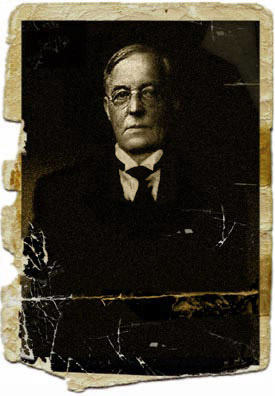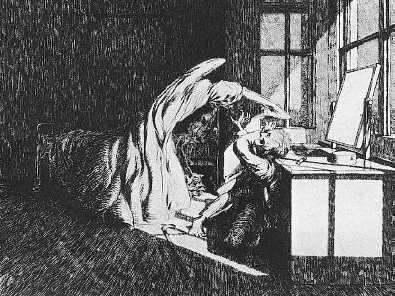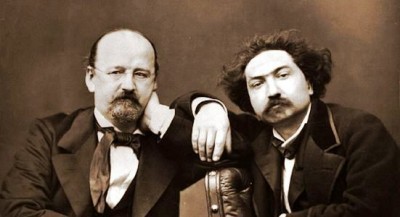You have no items in your cart. Want to get some nice things?
Go shopping
Today marks 150 years since the birth of the master of the ghost story, Montague Rhodes James. In the century since they were first published, James’s stories have never been out of print. In the general scheme of things, terror in literature doesn’t have a very long shelf life. New generations of jaded readers demand new thrills, and the jump-cuts and sound effects of horror in cinema and on television make the literary ghost seem rather tame. But James’s stories are still as terrifying now as they ever were.
There’s a sinister and repulsive imprecision about his ghosts; blanks that new readers fill with nervous imaginations. He does the literary equivalent of covering our eyes at the moment of horror. A few words dropped casually: face like crumpled linen, a creature made of hair, a man very thin and wet, a footprint with the bones visible. We desperately want to look, but even more desperately, we don’t want to see. We’re like the observers in “The Mezzotint“, “profoundly thankful that they could see no more“.
But of course, if you love ghost stories, you always want more. I’ve got shelves of the things, anthology after anthology promising scares and chills in the blurbs. But those of us searching for our next literary shudder know that, all too often, ghosts disappoint. They hang around not doing much, or do too much, like disembodied agony aunts. There are ghosts that turn out to be tricks, ghosts too airy-fairy to be scary, yawn-inducing amiable ghosts, and absolutely the worst kind of all, the comic ghost.

Roald Dahl once worked his way through pretty much the entire body of ghost stories written in English in an attempt to find 24 good ones to adapt for an American TV series. He was surprised to find that most were so poor he had difficulty getting to the end of them. In the introduction to Roald Dahl’s Book of Ghost Stories (1985), he wrote, “I couldn’t believe how bad they were,” concluding that “good ghost stories, like good children’s books, are damnably difficult to write.”
It’s rather useful then that Monty James, a voracious reader of supernatural literature and a fan of proper ghosts—the kind that make you dash past the dark shadow of the bathroom door and leap into bed—handily gave us a list of ghost stories that gave him that shiver of “pleasing terror” he so craved. In a 1929 article in the Bookman magazine, he summarised the history of the ghost story, picking out those examples of the genre that he returned to again and again. In celebration of his birthday today, here are five ghost stories by other writers that he loved.
1. “The Open Door” by Mrs Olliphant
James didn’t have much time for ghosts that weren’t scary, and this was one of only two stories he picked where pity rather than fear is the overriding emotion. That said, there is enough in “The Open Door” to send shivers down your spine. Something roams the ruins of an old house, calling to its mother to let it in: “a creature, restless, unhappy, moaning, crying, before the vacant doorway, which no one could either shut or open more.” The ending deftly sidesteps expectations.
2. “The Upper Berth” by F. Marion Crawford
There’s something fundamentally claustrophobic about a ship’s cabin, especially when you’re forced to share the confined space with a fellow passenger. In one of the most unpleasantly creepy ghost stories ever written, the upper bunk of an ocean liner cabin is inhabited by something that makes passengers run helter-skelter for the side of the ship in the middle of the night. James thought this stood “high among ghost stories in general”.
3. “The Familiar” by Sheridan Le Fanu
Le Fanu’s influence shows up strongly in James’s work. His stories are complex, the characters of the protagonists as important as the ghosts themselves. In “The Familiar”, a sea captain is haunted by the footsteps of some invisible thing. There’s a disquieting confusion over what the captain is so afraid of. He asks a doctor wildly, “Is there any disease […] which would have the effect of […] causing the man to shrink in all his proportions, and yet to preserve his exact resemblance to himself in every particular […]?”
4. “The Red Lodge” by H. R. Wakefield (Listen to a reading by Jim Moon)
Wakefield was much influenced by James, and although James called Wakefield’s ghost stories “a mixed bag”, he did enjoy some of Wakefield’s work. He didn’t elucidate which stories he thought “very inventive”, but at a guess, he might well have favoured “The Red Lodge“, in which a ghost’s oppressive presence causes children to drown themselves, and “Professor Pownall’s Oversight”, about a haunted chess game.

5. “The White and the Black” by Erckmann-Chatrian
Émile Erckmann and Alexandre Chatrian collaborated on a series of stories which “delighted” James. Their writing is characterised by the French/German culture of the Alsace-Lorraine region they came from. Known as “the twins”, they apparently worked out their plots while smoking and boozing together. Appropriately, in “The White & the Black”, a group of townsfolk are drinking in an alehouse when they hear news of the murder of a young girl. When the murderer bursts into the bar in the middle of a storm, he is pursued through the dark by something more terrible than remorse.
Our October theme is “Ghosts”. Submit now.

About Emily Cleaver
Emily Cleaver is Litro's Online Editor. She is passionate about short stories and writes, reads and reviews them. Her own stories have been published in the London Lies anthology from Arachne Press, Paraxis, .Cent, The Mechanics’ Institute Review, One Eye Grey, and Smoke magazines, performed to audiences at Liars League, Stand Up Tragedy, WritLOUD, Tales of the Decongested and Spark London and broadcasted on Resonance FM and Pagan Radio. As a former manager of one of London’s oldest second-hand bookshops, she also blogs about old and obscure books. You can read her tiny true dramas about working in a secondhand bookshop at smallplays.com and see more of her writing at emilycleaver.net.





“The Upper Berth” is one of my favorites. I read it as a child in an anthology bearing Alfred Hitchock’s commercial stamp (Ghostly Gallery, I believe it was) and it’s been clinging to me ever since. To this day I love any ghost story that bears a whiff of sea air… Robert Aickman’s “Ringing the Changes” is another good one in that vein.
Here’s to malevolent and odious ghosts!
I love “Ringing the Changes” too Andrea – such a creepy, oppressive atmosphere.
We might think of Perceval Landon’s “Thurnley Abbey”. In a letter to a friend James wrote “Percival Landon’s Raw Edges has a horrid one called ‘Thurnley Abbey’ which is included in A Muster of Ghosts by Bohun Lynch: almost too horrid.” I’d conclude that it impressed him, since it wasn’t quite horrid enough for him to condemn it – it certainly terrified me in my youth.
“The Red Lodge” by H. R. Wakefield https://www.donaldcorrell.com/wakef/riverp.html